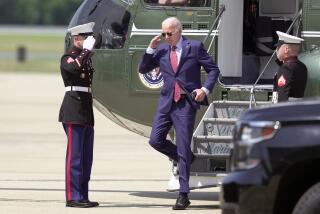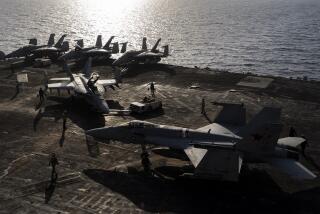Global Role Demands a 15-Carrier Navy
The Navy aircraft-carrier battle group is the most needed and most worked asset in our nation’s military arsenal. Yet despite the historically proven value of these ships, defense critics continue to make annual assaults on these backbones of our national and maritime strategy. Their goal apparently is a reduction of battle groups from the present number of 15. But to accomplish such a reduction would be a tragic mistake. For our Navy to meet its global peacetime requirements at a prudent level of risk to our country, 15 is the minimum number we can deploy. (In a global conflict, we would need 20 such battle groups, a figure continually validated by regional military commanders and through in-depth studies by the Joint Chiefs of Staff.)
Any discussion of carrier battle groups--in fact, any discussion of the Navy--must be undertaken with an understanding of the geopolitical framework of our country. As a maritime nation, our economic survival is dependent on the seas. Our vital interests are expressed in a web of more than 40 treaty relationships with binding coalitions for mutual defense. These relationships, together with the commercial dependencies that support our economy, shape our national security objectives. Stated simply, global commitments set the environment in which we live, work and prosper.
Meanwhile, the Soviet threat has not abated, despite the rhetoric of a brilliant public-relations campaign by Moscow. Soviet military spending continues to absorb a disproportionate amount of its gross national product. The growing Soviet navy is clearly offense-oriented with global reach. New and very capable warships of every type continue to be produced.
Additionally, low-intensity conflicts in the Third World provide a global threat from terrorists and other fanatics.
If we intend to secure our national- security interests, freedom of the seas is still a primary requisite. This means possessing a Navy deployed in strategic regions of the globe where it is needed to deter war and, if that fails, to respond with force.
No Administration, regardless of political persuasion, has been able to solve this protection problem with other means of force. A Navy operating in regional waters near potential conflict provides an advantage that cannot be approximated by forces based in the United States, regardless of how ready they may be.
If we are not going to have a permanent presence based overseas with our closest allies, then the only practical means of applying adequate force to a crisis and promoting regional stability beyond our own borders is to have that presence on station in international waters and airspace.
Electronically integrated, the carrier battle group--its complement of 80 to 90 multimission aircraft and accompanying cruisers, destroyers and submarines--provides a four-dimensional warfare capability. At a time when the battle sphere has expanded from the radar horizon to more than 1,000 miles, the carrier battle group provides a capability unmatched by any other military component inexistence.
Highly mobile and flexible, the battle group sends a strong political signal to an adversary. If need be, it can take complete control of an area. But if military power is not required and a political situation is stabilized, the battle group can simply steam away with no signals of retreat or weakness.
But why 15 carrier groups? Because a lesser number presents us with two unacceptable results: The first is that we will be forced to abdicate some global commitments, which would lead to diminished influence throughout an increasingly economically interdependent, multipolar and militarized world.
And because U.S. commitments will not decline, we cannot afford to take the strategic risk of a reduced carrier force structure. To meet our level of commitments with fewer forces would result in each ship and aircraft squadron having to be under way more, be gone from home longer and work harder. During the Iranian hostage crisis in 1979, the aircraft carrier Eisenhower battle group was deployed for 254 days with only five days in port.
Meeting our commitments with a smaller carrier force will result in cost increases, not savings. Overhaul and maintenance costs would go up, as we saw in the Vietnam era. Retention would go down, just as we saw in the 1970s when new commitments were added without an increase in carrier numbers. We ran sailors and their families into the ground and paid for it. So many chose to leave the Navy then that we were left with quantifiably lower levels of readiness--and a much-reduced level of confidence. This represents an institutional risk we cannot afford.
At our nation’s founding, Congress mandated that the Navy protect us and and ensure our survival and prosperity. Congress recognized our country as being maritime-dependent, and that fact has not changed.
More to Read
Sign up for Essential California
The most important California stories and recommendations in your inbox every morning.
You may occasionally receive promotional content from the Los Angeles Times.










